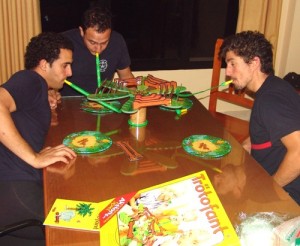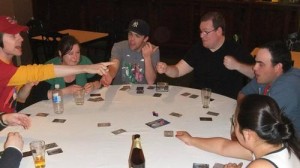
Game designers: when you see this during a playtest, you’ve got work to do. Image from the Baltimore Sun.
Young game designers quickly learn the importance of engagement. Basically, a player is engaged when he or she feels like a part of the game. An engaging game will make a player forget his or her real world problems. It will completely capture its players’ attention. In the early 21st century, a good indication that players aren’t engaged is the dreaded smartphone.
The worst culprit for disengagement is player elimination, but the most common culprit is players having long waits between turns. Long turns can be caused by any number of things, and I’ll go over a few common problems in a bit.
If long periods of downtime are one of the worst culprits, no downtime is one of the best ways to keep players engaged. Keeping all players active at all times, or maintaining simultaneous action, is one of the holy grails of game design. It’s something we as game designers should all aspire for. Today I’ll discuss how simultaneous action can work in board games.
Common Causes of Dreadfully Long Turns
Before we get into simultaneous action, let’s look at the villain of the story, long turns. While there are countless ways to make a game disengaging, the following three problems crop up all the time and can really sour a game experience by giving players too much time to get bored.
The first common problem is analysis paralysis. This is when players have too many options or too complex of options, so they take a long time to reach a decision. Citadels suffers from this problem. When players must consider not only which role would best benefit them, but also which roles other players will take and how those choices will interact with their role, decision times can be long and yawn inducing.
The second common problem is players having several decisions in a row, especially when some of those decisions depend on information the player doesn’t have in advance. Dominion frequently has this problem. Many cards allow players to draw extra cards, giving them information they didn’t have before the turn started, and many cards allow extra actions. Both of these together mean that turns can take a very long time.

Shuffling mid-turn slows the game down for everyone. Image from Wikipedia.
The final common problem is load time. This is any time when no one is making any decisions, but the game is being set up in some way, such as shuffling decks, rolling dice repeatedly, or restocking resources. Again, Dominion suffers here, as players can easily make decks that require shuffling in the middle of every single turn.
These are the sorts of problems you should be aware of, and which simultaneous action can help you avoid. Now, let’s take a look at some of the ways simultaneous action manifests itself in board games.
Real (Good) Time
While digital games and sports still remain the champions when it comes to real time action, some brave board and card games have delved into the world of real time. The challenge is that real time board games need something to govern the action. Sports have the laws of physics, and digital games have engines written in code. What’s going to run a board game, where players are used to taking turns?

I have never played Trotofant, which is driven by a motor and the lungs of the players, but I hope that one day I have the pleasure. Image from Board Game Geek.
Some games, like the children’s game Hungry Hungry Hippos, do employ physics. Games can also incorporate mechanical or electric engines (see Trotofant). Other games, like Space Alert, use digital media to drive the game. Perhaps at their most basic, games like Space Cadet use simple hourglass timers to impose structure on otherwise free-for-all gameplay.
There is also a tradition of games where the players simply race each other. Tessen, the recent Kickstarter success, features real time racing gameplay where your opponent acts as the timer. Space Cadets: Duel Dice takes a similar approach, but with teams.
Real time games tend to have three limitations. First, they can’t be all that complicated, or else players get frustrated and anxious (see Space Cadets: Duel Dice). Complicated real time games also greatly favor experienced players.
Second, real time games frequently have very limited player interaction. This isn’t always the case by any means (see Tessen, which is almost all player interaction), but for games with any serious complexity (like Space Cadet), player interaction is minimized to reduce conflicting player actions.
Finally, most real time games have an element of dexterity and quick thinking to them. This isn’t a limitation in itself, but some gamers absolutely hate games that require them to act quickly.
One Turn for All
Another common strategy for keeping players engaged is to make sure all players are invested in other players’ turns. Many party games use this tactic, such as Taboo. Even though one player is giving clues, the other players on his or her team are actively guessing, while the other team is keeping an eye out for mistakes.
Negotiating games also tend to use this tactic. In Settlers of Catan, players are always on the lookout for resources and trade opportunities on other players’ turns.

Whose turn is it? Everyone shares all turns in The Resistance. Image from Board Game Geek.
An extreme version of this is not even having separate turns: all players just have one turn. In The Resistance, players rotate who makes the final decision for the mission, but that’s more of a formality. In reality, every turn involves all players discussing what should happen on more or less equal footing.
My own game, Corporate America, makes use of taking turns with lots of negotiation in the Main Street Phase and all players sharing a turn in the Campaign Trail and Capitol Hill Phases. Engagement is one way in which that game shines.
One of the biggest drawbacks to this style of game is that time can fluctuate greatly. Quiet players may take only a minute to reach a decision, while noisy players may take ten. That kind of range can be dangerous, especially when players are left out of some discussions (such as running out of resources in Settlers or not getting any of your industries revealed in Corporate America).
These types of games also tend to have unstructured elements, which some gamers can’t handle.
All Together Now
Another common strategy for simultaneous play is to have all players make their moves at the same time, usually in secret. After making choices, all players execute their choices simultaneously.
Those who frequent the blog will know that one of my favorite mechanics, drafting, can make great use of simultaneous turns. In games like 7 Wonders, all players make a choice for each turn at the same time, so players only have to wait for the slowest player, not every other player at the table.
Other games, such as Gravwell, have all players make their choices simultaneously, but then resolve player actions in order. This preserves the speed of simultaneous play, since resolving actions in order takes much less time than making decisions in order. These types of games add interesting elements of anticipation and tradeoffs (often speed for power), but can get chaotic very quickly.
Musings
I’ve been thinking a lot about the “All Together Now” class of games lately because one of my non-digital projects (a game currently called Factions) makes heavy use of all players making simultaneous, discrete choices. The original inspiration was for a game like Citadels (easily one of my favorite games) but with less downtime and analysis paralysis.
In the game, players take part in several battles. In each battle, players begin by drafting a hand of cards (much like 7 Wonders, but without revealing their cards after each pick) and then play three of the cards they drafted in three waves to determine the outcome of the battle. Each wave involves all players playing a card at the same time and then resolving their choice simultaneously–I’ve worked hard to remove ordering from the game. In doing so, I’ve discovered a couple interesting things.
First, player choice needs to be limited to the card he or she plays. I’ve been able to sneak in a little more choice by allowing players to use another card in a “post-wave” phase, but for the most part, a card cannot give a player any more choices than simply playing that card. If players can choose targets or the like, order will sneak in when two players play cards that give them extra choices.
Second, games like this get chaotic quickly. 7 Wonders manages to support an impressive seven players, but that is in large part because there is very little player interaction outside of drafting. In the base game, players can only interact with their direct neighbors. If you want players to be able to interact with everyone else (like I do), the player limit will probably be lower (it’s looking like five for Factions).
In It Together
There’s a long history of taking turns in games, and for good reason: it structures the action in a coherent and easy to understand way. Turns also give a lot of freedom to the designer to come up with whatever game actions he or she wants.
But turns come with a cost of time and attention. When turns are fast, that’s not a serious cost. But when turns drag on, you’re losing one of the most important things your game can provide your players: engagement.
The various forms of simultaneous action can help solve that problem. Each has its own limitations, but each also solves problems that your games may be suffering from.
As a concrete example, in the early development of Corporate America, players took turns drafting (Citadels style) and playing business cards in the Wall Street Phase. In a game that was almost always simultaneous and engaging, this really stood out as causing a lot of down time.
The solution was to have all players start their businesses simultaneously. This results in more randomness and a little less strategy, but it also results in players getting to the exciting, engaging part of the game more quickly.
Even if your game has some non-simultaneous aspects, incorporating some simultaneous action could be just what it needs to speed things up and keep players engaged.

Jamey Stegmaier
/ September 16, 2013This is a great read, and something I’ve been thinking about a lot lately. The less downtime in a game, the better, but there are so many other things to balance. I like your point about 7 Wonders that instead of waiting for all players, you’re only waiting for the slowest player. I’ve played a fair amount of 7 Wonders lately, and I’ve been trying to decide if I like that downtime (you can also see that type of downtime in Libertalia). Usually I know the card I want to play immediately, so ALL of the other players are the slowest players from my perspective. However, your point made me realize that I can socialize with the other players as they pick their cards.
I think that cooperative games facilitate downtime better than any other game because everyone is involved on every turn (at least, the good cooperative games are that way). That leads to other issues (like dominant players), but there are ways to mitigate that.
Anyway, thanks for the great post. It definitely got me thinking.
Dagar
/ January 29, 2015Hey Teale,
thank you for your insight in simultaneous gameplay. The game I am currently designing has a heavy simultaneous element, so this blog has provided me with some useful information and association.
What your blog entry lagged in my opinion were the downsides of simultaneous game play. You mentioned possible chaotic times and a little less strategy for the players. For the designer however, evolving a mechanic of your game from turn-based to simultaneous might mean hassle in terms of taking out complexity (which might subtract some immersion, if not well handled) and having to add rules to make sure there can be no contradictions. Adding rules however often leads to a less easily understandable game, which means that it is less appealing for a greater audience.
Sure, this is all theoretical and with enough experience in the design business and enough time with your project you can mitigate these effects. But in my opinion they should be mentioned anyways.
Sorry for my halting english, I am no native speaker.
Josh ‘Dagar’
teale
/ January 29, 2015Hi Josh,
You’re absolutely right that I focused on the positives of simultaneous play here and swept some of the negatives under the rug. Simultaneous play is not perfect, and at the very least requires some sacrifices. Since working on more simultaneous games, I realized that not having bathroom breaks can lead to some very uncomfortable game sessions!
In your case, I would guess a lot of your problems come from translating a turn based game into a simultaneous one. Turn based and simultaneous game structures are fundamentally different, so trying to convert one into another will create a lot of messy problems. If I were in your shoes, I would scrap what you had from the turn based version, really think about how the simultaneous system works, then rebuild your game from the ground up. Reference your old version for inspiration, but don’t feel like you need to force any of it into the new system. You will end up with something that embraces simultaneous gameplay and has far fewer contradictions and messy special rules. Good luck!
Dagar
/ February 1, 2015Hey again teale,
thank you for your quick answer. Indeed, my first draft was a turn-based design that I turned into a simultaneous, time-critical design. And yes, it was quite some time since I was satisfied base frame. Currently, I am working on the first prototype.
So, dear reader, if this blog appealed to you and you think of turning your draft into a simultaneous one, better do it now, and do it rigorously: throw out everything that does not fit well. The resulting draft will be less complex and lack many original mechanics, but it hopefully will be more engaging and immersive.
Teale, good luck on your future projects as well!
Josh ‘Dagar’
Gilbert Walker
/ July 10, 2016Hey thanks for the great post. Really got me thinking. There’s lots of interesting options in simultaneous actions, but yeah, there’s tricky limitations too!
Interestingly, I’m trying to design a game that sounds similar to your “Factions” game. Have you finished it yet? I’d love to play it!
Thanks so much for an informative and thought provoking post!
teale
/ July 10, 2016Glad the thoughts have inspired more thoughts! Factions did make it to print. It’s now called Shadow Throne, and is available at your friendly local game store (you may need to request they order it) or through the Nothing Sacred Shop: http://www.nothingsacredshop.com/shop/shadow-throne-preorder